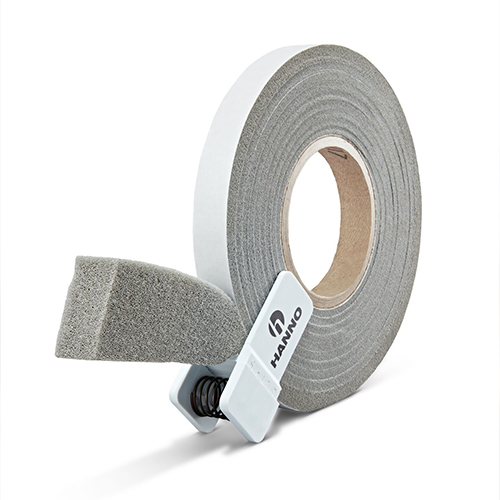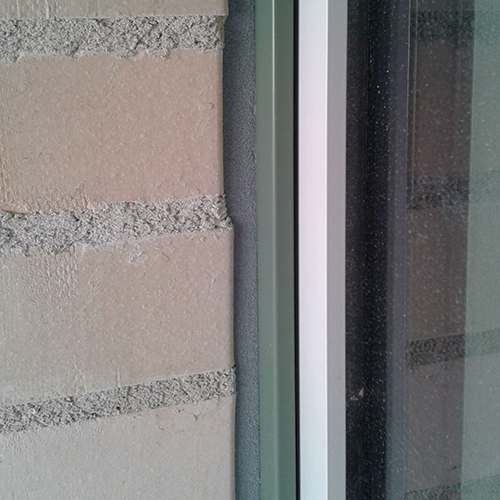Sustainable joint sealing in façade construction
Hanno sealing tapes for sealing joints in façade elements and masonry joints fulfil the highest requirements. The well-known Hannoband-BG1, for example, clearly exceeds the requirements of DIN 18542. After an outdoor weathering test over 15 years, the tape was shown to have a recovery of 250-300 % of __GLOSSAR_b129177e581390b4bf50bf7347cf35230__. Correctly dimensioned, the sealing tapes from HANNO can also be painted over.
sealing tape with qualities
Joint seals with a Hanno-sealing tape guarantee a higher level of protection thanks to functional membranes and strong recovery properties. The tapes also offer high thermal and sound insulation. For façade work, the joint seals can be applied quickly with roll lengths of up to 24 metres. Numerous test reports and product certifications from recognised testing and certification bodies confirm the quality of the sealing tapes.
Hannoband-BG1 or Hannoband-BSB BG1 as fire protection tape
Hannoband-BG1 is particularly suitable for long-term, optimised joint sealing. The first-class sealing tape exceeds all DIN 18542 requirements for driving rain tightness, air tightness and weather resistance. It also impresses with its diffusion openness and paint compatibility. Hannoband-BSB BG1 - a special fire protection tape that is flame-retardant - is used to ensure fire resistance. It is used for partition walls and fire doors, among other things, but the sealing tape is also suitable for special window and façade constructions.
At HANNO you will find an extensive product range of joint sealing solutions - in addition to seals for façade construction, HANNO offers sealing tape-expert also offers products for sealing window joints or special drywall solutions.
Joint tape with physical effect
Jürgen Maurer (Managing Director of Hanno (Schweiz) AG) spoke to Dora Horvath about the importance of an early sealing concept in the planning stage and the question of how sustainable joint sealing tapes are.



Mr Maurer, when should joint sealing on façades be planned?
This is best done during the planning phase in order to optimise the joint sealant. Ideally, the architect should select the specific products themselves. However, experience shows that the joint sealants are often only determined on the construction site, which means that the joints are often too narrow or too large and therefore cannot be sealed properly. The joints must not be less than eight and not more than 35 millimetres for standard-compliant sealing.
What needs to be taken into account during planning?
The joints must have a certain width in order to ensure standard-compliant, durable and functional waterproofing. This also ensures that structural movements in the joint are safely absorbed. In the façade, it is extremely important that the movement absorption, UV resistance, driving rain tightness, wind tightness, sound insulation and fire protection function permanently.
How complex is the installation of your waterstops in a dilatation joint?
The "Hannoband BG1" and "Hannoband BG1-M" joint sealing tapes are pre-compressed on the roll and are simply inserted into the joint. They are self-adhesive. This means that they can be easily placed in the desired position using a spatula. The tape then opens automatically in the joint, which means that the installation time is much shorter than with a sealant.
How does installation work in winter?
Our joint sealing tape can be easily applied even in sub-zero temperatures and wet conditions, as it is pressed and not glued. Priming is also not necessary, as the joints can be uneven, damp and dusty. The pre-compressed sealing tape is pressed between the joint flankn and thus ensures tightness through the contact pressure.
With sealant joints, you often see a flank tear, which causes the joint to leak. How does the pre-compressed joint sealing tape behave?
Since the joint sealing tape is permanently pressed into the joint, flank tear-off is ruled out. HANNO guarantees that its BG1 joint sealing tapes will function for up to 15 years, including UV and weather resistance. All tapes are also tested in accordance with DIN 18542/2009.
What colours are available? And can the tape also be painted over?
The tapes are available in light grey, grey and black. Light grey goes very well with exposed brickwork. This is because joint mortar is also usually light grey, so the tapes are almost invisible.
The joint sealing tapes can only be painted over with a diffusion-open façade paint to a limited extent: As the paint adheres very well to the tapes, but does not usually absorb any movement that occurs, this can result in small cracks in the paint, although these can only be seen close up. The tightness of the joint sealing tapes is of course not affected by these cracks because the tape adapts to the joint despite the colour.
Is it possible to renovate joints in the façade with a joint sealing tape?
This is actually much easier, safer and more durable than using a sealant. When renovating with sealant, the old sealant should be removed without leaving any residue, as the adhesive bond to the substrate must be ensured. Incompatibility and rejection of the different sealants must also be expected. As a joint sealing tape does not require an adhesive bond with the substrate, it is sufficient to simply cut out the old sealant and then insert the joint sealing tape. That's it!
Now to the windows: Are there any differences between plastic windows and other types of windows?
Wooden frames are easy to seal as they have a smooth surface. Plastic frames and metal frames, on the other hand, are profiled on the sides. Sealing these is not so easy. Hanno has therefore subjected the functionality of its sealing systems to a component test. For this purpose, a "Hannoband BG1" was applied to the back of the frame of a PVC window without using a profile filler.
What about fire protection?
We have a special tape in our range for this purpose: "Hannoband BSB BG1" fulfils the requirements of the fire resistance class up to EI 120, with VKF approval.
Bonding components and foaming cavities is sometimes criticised because the components are often bonded in such a way that they are difficult to separate during dismantling. What solutions are there?
This clearly speaks in favour of joint sealing tapes, which only ensure tightness through their contact pressure, without gluing. This makes them easy to replace and remove at any time.
What do you say to concerns about joint sealants emitting substances that are harmful to health?
Here too, joint sealing tapes made from PU foams offer a safe and ecological alternative. Reacted polyurethane no longer contains harmful monomers and isocyanates. Isocyanates can trigger allergies and are suspected of causing cancer. Our tapes are EC1Plus-tested and approved for Minergie-Eco buildings. Emicode EC1Plus is the seal for particularly low-emission and ecological building products that exceed the standard EC1 category. For the classification, the sum of volatile (VOC), carcinogenic and semi-volatile (SVOC) organic compounds is tested after three and 28 days respectively.
__________
This interview has already been published on www.baudokumentation.ch and in Hanno-News.







